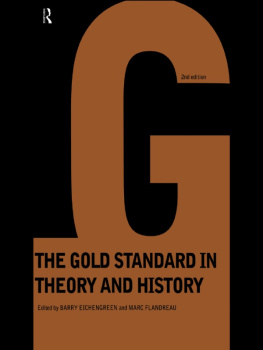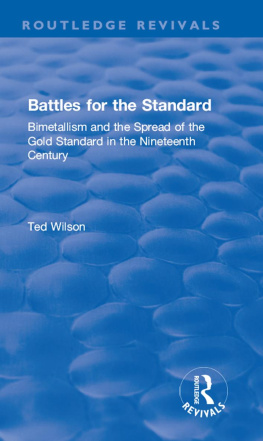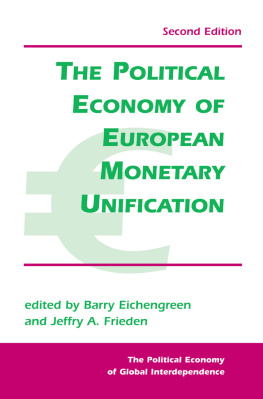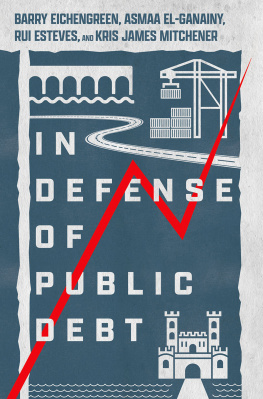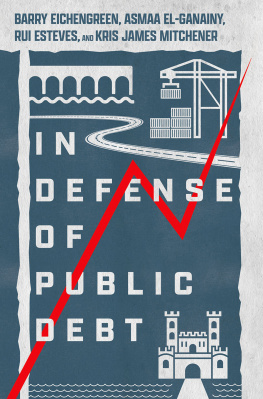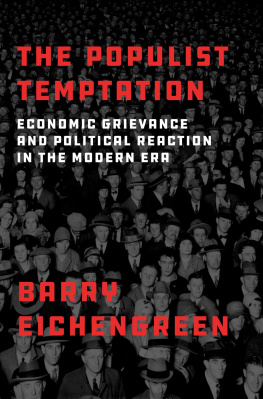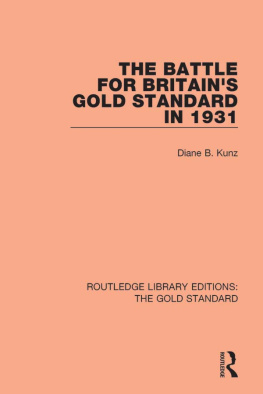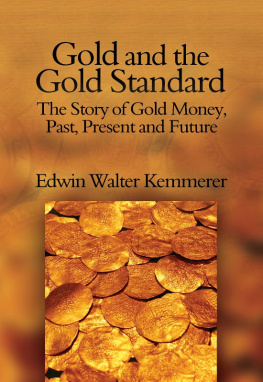Eichengreen Barry - Gold Standard in Theory and History
Here you can read online Eichengreen Barry - Gold Standard in Theory and History full text of the book (entire story) in english for free. Download pdf and epub, get meaning, cover and reviews about this ebook. year: 2011, publisher: Taylor & Francis Group, genre: Science. Description of the work, (preface) as well as reviews are available. Best literature library LitArk.com created for fans of good reading and offers a wide selection of genres:
Romance novel
Science fiction
Adventure
Detective
Science
History
Home and family
Prose
Art
Politics
Computer
Non-fiction
Religion
Business
Children
Humor
Choose a favorite category and find really read worthwhile books. Enjoy immersion in the world of imagination, feel the emotions of the characters or learn something new for yourself, make an fascinating discovery.
- Book:Gold Standard in Theory and History
- Author:
- Publisher:Taylor & Francis Group
- Genre:
- Year:2011
- Rating:4 / 5
- Favourites:Add to favourites
- Your mark:
- 80
- 1
- 2
- 3
- 4
- 5
Gold Standard in Theory and History: summary, description and annotation
We offer to read an annotation, description, summary or preface (depends on what the author of the book "Gold Standard in Theory and History" wrote himself). If you haven't found the necessary information about the book — write in the comments, we will try to find it.
Gold Standard in Theory and History — read online for free the complete book (whole text) full work
Below is the text of the book, divided by pages. System saving the place of the last page read, allows you to conveniently read the book "Gold Standard in Theory and History" online for free, without having to search again every time where you left off. Put a bookmark, and you can go to the page where you finished reading at any time.
Font size:
Interval:
Bookmark:

The Gold Standard in Theory and History
The revised edition of this acclaimed book provides a comprehensive analysis of the theory and history of the gold standard. It contains six new essays drawing on the latest research to provide a framework for contemporary debates about the gold standard. New topics include:
Applications to the gold standard of the post-1990 literature on exchange-rate target zones
The significance of the gold standard in the European Monetary Union debate
The Gold Standard in Theory and History will be an invaluable resource for students of macroeconomics, international economics and economic history at all levels.
Barry Eichengreen is John L.Simpson Professor of Economics and Political Science at the University of California, Berkeley. He has written books on a wide variety of economics subjects. Marc Flandreau is a researcher at the Centre National Recherche Scientifique in Paris, and an associate researcher at the Observatoire Franais des Conjonctures Economiques, Paris. He is a specialist in the theory and history of the international monetary system.
First published in 1985 by
Methuen Inc
29 West 35th Street, New York, NY 10001
This edition published in the Taylor & Francis e-Library, 2005.
To purchase your own copy of this or any of Taylor & Francis or Routledges collection of thousands of eBooks please go to www.eBookstore.tandf.co.uk.
Second edition published 1997
by Routledge
11 New Fetter Lane, London EC4P 4EE
Simultaneously published in the USA and Canada
by Routledge
29 West 35th Street, New York, NY 10001
1997 Barry Eichengreen and Marc Flandreau
All rights reserved. No part of this book may be reprinted or reproduced or utilized in any form or by any electronic, mechanical, or other means, now known or hereafter invented, including photocopying and recording, or in any information storage or retrieval system, without permission in writing from the publishers.
British Library Cataloguing in Publication Data
A catalogue record for this book is available from the British Library
Library of Congress Cataloging in Publication Data
A catalogue record for this book has been requested
ISBN 0-203-97887-0 Master e-book ISBN
ISBN 0-415-15060-4 (hbk)
0-415-15061-2 (pbk)
For Michelle, pour Mathilde
This is the second edition of The Gold Standard in Theory and History, revised after an interval of twelve years. In addition to comprehensively revising the editors introduction, we have recast the table of contents, dropping three chapters from the first edition and adding six new ones.
The editors and publisher would like to thank the following for permission to reproduce copyright material.
P.B.Whale and Tieto Limited, , which originally appeared (in French) in Bretton Woods: Mlanges pour un Cinquantenaire (Association dconomie financire).
Editors introduction
Barry Eichengreen and Marc Flandreau
The financial globalization that followed the collapse of the Bretton Woods System opened a new chapter in the history of international monetary relations. The founding fathers of Bretton Woodsthe eminent British economist John Maynard Keynes and US Treasury official Harry Dexter White prominent among them sought to create a more perfect international monetary order conducive to financial stability and economic growth. Their system was crafted to contain destabilizing flows of hot money and to allow governments to adjust policy to domestic conditions. For a few years it seemed to work. But by the 1970s international financial markets had regained the upper hand. International capital flows seemingly unprecedented in scope first undermined fixed currency pegs. Following the transition to floating exchange rates, financial markets threatened officials seeking to avail themselves of their newfound freedom with capital flight, the collapse of the currency, and inflation. When US President Bill Clintons advisor James Carville famously remarked that if reincarnated he wanted to come back as the bond market, he was only articulating many officials sense of helplessness when confronted by a world of global finance.
Critics of the current system contend that the generalized float now prevailing provides neither the stability needed for effective international specialization nor the flexibility required for independent action. Turbulence and volatility in international financial markets disrupt firms production and investment decisions. Misaligned currencies confer arbitrary competitive advantages, evoking complaints from those who produce in competition with imports. The temporary trade restraints adopted in response are not easily removed once the exchange-rate fluctuation is reversed.
Dissatisfaction with current arrangements naturally prompts proposals for reform. Virtually all such proposals seek to limit exchange-rate variability by establishing a system of multilateral currency bands (or their variants: crawling pegs and target zones). The member states of the European Union, among whom economic integration is particularly close, have established the European Monetary System (EMS), a multilateral exchange-rate grid, to limit the variability of their currencies. Countries as diverse as Finland, Sweden, Mexico, Argentina, and Estonia have pegged their exchange rates to the currencies of major trading partners for various periods of time.
But the decision to peg the exchange rate is easier to issue than to enforce. In 19923, the European Monetary System erupted in a crisis that expelled two major participants, Italy and the United Kingdom, from its Exchange Rate Mechanism and forced the remaining countries to widen their fluctuation bands from  to 15 per cent. The Mexican policy of pegging the peso to the dollar came asunder in 1994, when an attempt to realign led to a full-blown panic and financial collapse.
to 15 per cent. The Mexican policy of pegging the peso to the dollar came asunder in 1994, when an attempt to realign led to a full-blown panic and financial collapse.
The implication is that pegging the exchange rate has become exceedingly difficultsome would say impossible for any length of timein todays world of liquid financial markets and quicksilver capital flows. The resources commanded by currency traders far exceed the reserves of central banks. By forcing governments seeking to defend the currency to raise interest rates to politically insupportable levels, the markets have the capacity to demolish the peg at any time.
Things may have been different under the Bretton Woods System of pegged-but-adjustable exchange rates, but this was because controls limited international capital movements, sheltering currencies from market pressures. In todays globalized capital markets, where capital controls have become exceedingly expensive to enforce, countries will inevitably gravitate toward greater exchange-rate flexibility.
The gold standard is the obvious challenge to this conventional wisdom. When it prevailed, currencies were successfully pegged against one another despite the presence of open capital markets. Yet exchange rates were stabilized within 1 per cent bands for extended periods, a record of stability that remains unparalleled even today.
Popular images of the gold standard reflect present problems as much as past realities. When the first edition of this book appeared a dozen years ago, the appeal of the gold standard was its association with price stability. Countries were just emerging from the high inflation of the 1970s. The fact that prices had been little different in 1870 and 1913 recommended the system to those who valued price stability. In the course of the last ten years, inflation was brought under better control, and its threat was superseded in the eyes of many by the problem of exchange-rate instability. Correspondingly, the appeal of the gold standard today is as a mechanism for stabilizing exchange rates and smoothing the balance-of-payments adjustment process.
Font size:
Interval:
Bookmark:
Similar books «Gold Standard in Theory and History»
Look at similar books to Gold Standard in Theory and History. We have selected literature similar in name and meaning in the hope of providing readers with more options to find new, interesting, not yet read works.
Discussion, reviews of the book Gold Standard in Theory and History and just readers' own opinions. Leave your comments, write what you think about the work, its meaning or the main characters. Specify what exactly you liked and what you didn't like, and why you think so.

